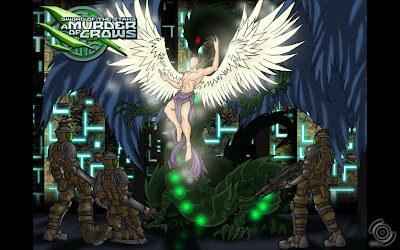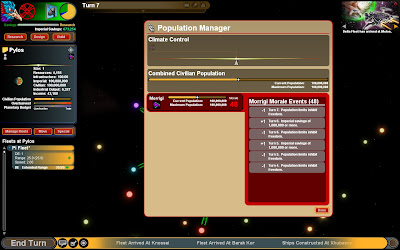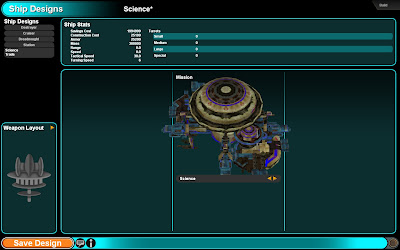
A "stellar" series:
I think it is only fair, as a preface to this review, that I publicly state just how much I love the Sword of the Stars series (hereafter SotS). Professional reviewers criticized the original SotS for its rather shallow turn-based section - devoid of diplomacy, trade, or the micromanagement of planet development - and complained about the tricky RTS tactical battles - with "realistic" inertial effects, a relatively unintuitive need for Command and Control Ships, and complex weapon firing arcs. I saw, however, an elegantly simple strategic mode focused wholly ship building, economic development (to build more ships), and technological research - you guessed it - to improve ship components. I felt that the tactical real-time battles, while at first difficult to learn, held a complexity that (red) dwarfed even Medieval 2: Total War. Sure, the game was 98% focused on war, but this didn't mean the game was not worth playing, on the contrary, it was a down-and-dirty brawl with few distractions. I felt that the unfavorable comparisons to Master of Orion 2 were spurious, SotS was never intended to be a MoO2 clone. Instead, SotS played more like the classic game Stars!, a turn-based game that also focused on ships and warfare and eschewed MoO2's Civilization style building up of planetary infrastructure for simple slider bars - something that SotS copies well. SotS stood out from the pack for its inventive races, each with their own unique strengths and weaknesses, methods of ship propulsion, and slightly different tech trees (which are randomly generated each game with different percentages for certain techs to be available for each race). The writing for the games was all done by the talented Arinn Dembo, whose imagination is only eclipsed by her excellent writing skills. To top it all off, some of the voice talent was done by Toren Atkinson, one of the front men of a band dedicated the writings of H.P. Lovecraft.
Predictably, the release of Born of Blood (hereafter BoB), SotS first expansion pack was highly anticipated by its fans, myself included. BoB revolutionized the SotS system, adding rudimentary diplomacy, a deceptively simple trade system, and most notably the Zuul, giant patriarchal muskrats with telepathic males and burly females with giant claws and armor rending teeth. The Zuul were gruesome, evil, and bloodthirsty. Their ships were massive weapons platforms "duct-taped" to engines and barely hanging together as they pummled their enemies. The new tech in BoB improved SotS tremendously, almost providing a completely new gaming experience. Most of the remaining issues with the real time combat were gone, patches and the expansion allowed for selective weapon targeting, the showing of firing arcs, 3D pivoting on the 2D map, and cleaner ways to control large groups of ships (and the battles in SotS can contain dozens of ships, with literally hundreds waiting to enter as reinforcements). The changes made in BoB managed to convince many, who had dismissed SotS upon a cursory playing of the demo or a glance at the mediocre reviews, to happily join the fold of ravaging space-muskrats looking for their "biological" parents (the Zuul are a bioweapon deployed by a yet unknown race).
AMoC Time:
So now we arrive at A Murder of Crows, lovingly referred to as AMoC among those "in-the-know." The question on mosts fans mind is, "will AMoC live up to the hard-t0-fill shoes of this "blood" brother (man these puns are getting worse)?" Well, here is the definitive answer folks - sorta kinda.
AMoC, like BoB, continues to add slightly more complexity to the still relatively streamlined gameplay of BoB and SotS (Born of Blood is required to run AMoC, or at least the newly released Gold Edition). From a storyline standpoint, the original SotS was about Empires expanding and forming, BoB was about Empires shoring up their defenses and creating frontier settlements, with AMoC as the "next step" in the SotS evolution. Frontiers are beginning to civilize, civilians are moving into these formerly frontier planets, trade lanes are becoming well-traveled, independent settlements have formed outside of official imperial boundaries, and the races have begun to spend more time trying to understand each others' language and culture before lancing them with phased light particles.
In gameplay terms this means the addition of a population manager and xeno-culture technology tree to simulate the new influx of civilians and "peace-love-and-understanding" between the races. Formerly, the language techs (added in BoB) were only required to make non-aggression pacts and alliances with the enemy, doing little else and often ignored for newer, shinier torpedo techs. In AMoC, however, the new and fully fleshed-out xeno-culture tree plays a very important role in both diplomacy and warfare. Formerly, the only ways to take over an enemy planet was to eradicate the enemy and colonize it with your people or shoot the enemy with a very specialized "conversion" plague that switched their allegiance over to you. In AMoC, populations are now split up upon planets - numbers for Humans, Liir, Tarkas, Hiver, Zuul, and the new Morrigi, are all individually calculated. This means that, if you are playing as the humans, you can now invade a Hiver world and continue to have Hivers living on your newly conquered planet, conferring their particular Hiver bonus to production for that planet. To do this, however, you have to have reached a certain level of the new xeno-culture techs that allow you to assimilate and accommodate these carapaced new citizens. Once you have these techs, you can set the numbers of Hivers (or whatever race) you want to allow to live on your planets (one new tech even allows you to "proliferate" enemy races to your other worlds) and decide what way to terraform the planet to best please whatever races are living there. This is all done with the aforementioned population manager and a simple set of sliders. Further, the xeno-culture tree isn't all about tolerance and breeding foreign sentient bugs, the higher levels of tech allow you to demand the immediate surrender of foreign planets, if your invading force is large enough, without firing a single shot. This was a much needed addition, as the final stretch of "kill, hunt, kill, hunt, kill" to root out the remaining colonies of a losing race was one of the least interesting aspects of SotS and BoB.

The xeno-culture tree is not without its flaws, however. Like I said, these are important techs, but each one of these you spend 6-12 turns on is a weapon tech or an industrial tech that the AI (or a human opponent) is researching. Further, to "force" the need to research these xeno-culture techs, Kerberos has added "independent planets" to the game. These are basically one planet "minors" that are populated by one of the game's major races. Upon finding these worlds, they will be unclaimed and protected by only a small ring of light satellites. If you have the proper race incorporation technology, you can instantly claim the colony, which will have a decent civilian population and infrastructure (as well as be terraformed to that race) but will have low industrial output while your imperial population slowly grows. This is, in theory, a good system, but in practice I have found it a tad unbalanced. In last game I played, I found about five of these independent worlds, of my own race, right in my backyard. This allowed me to grow my empire without having to build colony ships, spend money terraforming, or do anything more than send a small scouting party. However, the AI's luck did not fare so well, and it did not have many of these "free" colonies near it and so it fell behind in the colony race. In contrast, I played a game where I did not get any of these at all, and the AI got several. Because colonies provide money and industrial output for ships and tech, this "luck" based method of getting free colonies can create a very skewed match. I have yet to find a way to turn these independent colonies off in the game creation utility - so it certainly pays to scout far and wide as soon as possible to find your lost brethren.

This game is for the birds...
Obviously, one of the major highlights of the new expansion is the inclusion of the strange and mysterious bird-race, the Morrigi. Called "the Crows," the Morrigi are apparently an ancient race that chose to evolve into some sort of cross between a large raven, and a 13-year old girl's vision of a "pretty fairy dragon." The Morrigi are a stealth and "trickery" based race, or so the manual and product description says. To me, they seem more of a "run" and "pelt from afar" race, who rely upon fast tactical drives, mines, and primarily drones - the SotS term for carrier-based fighter ships. The addition of carrier-based fighters, something fans have been calling for since the first patch, and something actively resisted by the Kerberos development team since said patch, seems to fit perfectly with the Morrigi. The Morrigi rely upon large numbers, like the Hivers, but their ships are fragile much like the Liir. Most of the Morrigi ships are also outfitted with, and try not to laugh, generous rear firing arcs so that they can tactically retreat, screening the enemy with mines and drones while firing backwards. The Morrigi's ship drive relies upon this "numbers" strategy as well - the more ships you have in a fleet, the faster the Morrigi fleet will go.
I found the Morrigi to be quite a challenge to play. Their tech development seems faster than the other races, but the fragile nature of their ships and the hit-and-run tactics were not particularly to my liking. Other players will certainly like these aspects, but even fully shielded and with the addition of more armor, Morrigi ships are torn through like paper, even against technologically inferior foes. The tactical battles occur fast and furiously enough already, making the Morrigi so weak means that you are constantly having to manage incoming reinforcements while attempting to keep key ships alive by firing and moving. Compare this to "staight at the enemy strategy" of the heavily armed and armored, but tech-poor, Hivers and you get a different and much more hands-on battle. Some will like this, but I am still trying to overcome the Morrigi's learning curve. Even so, the Morrigi are nowhere near as interesting aesthetically, play-wise, graphically, or strategically as the Zuul, and they don't draw the player into their twisted and warped philosophy for universal dominance like BoB did. Perhaps this is just me, and certainly others might find them just as outstanding, if not more, than any of the other races available.

Drones are also a little less exciting than one might think. Obviously, large swarms of drones can be devastating to enemy ships, particularly when they are armed with the new persistent-firing small beam weapons (yes they DO look like the Shadow Fighter weapons in Babylon 5!). Still, drones are weak and can't seem to be controlled by the player (I am assuming they attack the ship that I have the carrier target), which is a little odd for a combat system that allows the player to target specific spots on enemy ships (you can target weapons and blow them off, for example). I would think that drones should be the perfect surgical tool to take out enemy weapons or engines, rather than just an annoying swarm that fires upon any section of the ship it is near. Maybe I am not using them correctly, which is a distinct possibility.
That last statement brings me to the biggest criticism of AMoC, and the SotS series, in general. The gameplay is only simple in the most shallow of levels. Underneath the initial impression lies a game full of options where one false move can spell slow death due to economic, technological, or military stagnation versus your foes. The RT tactical battles hold a plethora of mostly undocumented manuevers, weapon uses, and mechanics. For example, I was just informed by Sepiche, a poster on Octopus Overlords, that placing ships in the shadow of a planetary asteroid will disrupt the lock of planetary and ship-based missiles! I have been playing this game since it released, and I had never seen that happen, and each game I feel like I learn more and more about the combat system. Now if you are an avid forum-reader or frequent fan-made wikis, then you can read up on all the undocumented tactical and strategic "surprises" available in the game, and get a more indepth account of the difference between the races in terms of ship armor placement (Tarkas have more in front, Morrigi more in the back), race production and research modifiers, as well as a slew of other things you won't find in the manual or on an in-game tooltip. In many ways, each tactical battle is like the Kobayashi Maru, a trial by fire to train you in new and sometimes unorthodox ways to fight. I can understand having the player discover some surprises by themself, but sometimes having a litte documentation and hand-holding can certainly help new players build their own inventive strategies.
The Morrigi and xeno-cultural techs are the major additions, but they are only the tip of the iceberg of a host of smaller tweaks and techs added by AMoC. Each race benefits from the addition of huge space stations, which augment trade, research, and ship command, depending upon which is built at the planet (and which require specialized construction ships to create). Many new weapons are added, particularly to the mass driver line, including a shotgun driver, a long range "sniper" mass weapon, and a cool rapid-fire "Gatling" driver. There is a new planetary morale system that requires a bit of babysitting, lest your planets revolt - but the system requires the micromanaging of planetary population limits and breaks with the more elegant "hands off" design scheme of the previous two iterations of SotS.

Second star on the right, and straight on till morning:
In summation, AMoC brings a lot to the table, but it isn't quite the tummy-rubbing meal that was brought by the Zuul (ugh, bad analogy, I would hate to see their meatloaf). Many of the additions should have been present in the series at the beginning - surrendering enemies and drones - and others add complexity that, while fun and able to breath new life into an aging game, also break the original and simple initial design. Obviously, this was a dangerous balancing game. With critics complaining about the "shallow" nature of the game and fans loving the elegant lack of micromanagement, Kerberos had to do something to please old fans and attract new ones. However, their effort ended up pushing the game just ever so slightly into the realm of being too much micromanagement, and heightened the already large learning curve with more, mostly undocumented, features. The mystery of exploration and tension of heated battles are still there, however. Each new planet might bring bizarre random events, each new turn could herald the arrival of a new and massive galactic threat (which is best if not spoiled) and, while not dark and ominous as BoB, AMoC chose the more complicated civilized path to bring a rewarding expansion for one of he finest space epics available.
Benediction:
Score - 8.0/10
Pros: Loads of new techs make for more to discover, the addition of planetary surrender, space stations, and drones. Tactical battles still some of the best in the RTS market. Races have a lot of personality and the writing is excellent (added race descriptions to race choice screen).
Cons: Simple SotS gameplay bogged down by micromanaging planetary morale, trade lanes, and alien populations. Some of the game's coolest aspects remain undocumented and require the player to "stumble" upon them, increasing the learning curve. Morrigi are not quite as interesting as the Zuul where, and require overly hands-on tactics. Graphics are starting to show their age, particularly the ship textures.
Nota Bene: In regards to the AI, none of addressed the relatively poor performance during tactical battles. The AI still doesn't use some kinds of weapons frequently, if at all (such as corrosive missiles) and tends to prefer to "put ships in eschalon and full bore into the player's ranks." Thus the AI can be tricked by skilled players, and isn't particularly cunning. However, the strategic AI is much better, as it is efficient at maximizing its production and research, in scouting widely and well, and in creating HUGE fleets (although it doesn't take much advantage of repair ships). The game is build around, and really created for, multiplayer. However, living up to my name - Eremite means hermit - I haven't ever played SotS against another human being.
Also, it should be noted, for those that don't know, there is an auto-resolve button that quickly resolves battles without the need to play the real-time portion. The results are not as good as playing the battle out yourself, but they tend to be reasonably accurate with a higher rate of casualties. The game length is usually about 8 hours to much longer, around 20 hours for a match (if you set a high number of starts, default tech and economy rate, and a large number of players).
